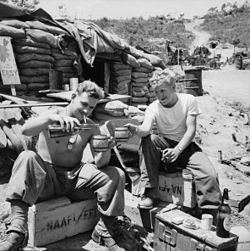Founded 1950 | ||
 | ||
Similar Greek Expeditionary Force, Royal Australian Engineers, IX Corps, Second Australian Imperial F, Fourteenth Army | ||
British Commonwealth Forces Korea (BCFK) was the formal name of the Commonwealth army, naval and air units serving with the United Nations (UN) in the Korean War. Australian, British, Canadian, Indian and New Zealand units were part of BCFK. Some Commonwealth units and personnel served with United States and/or other UN formations, which were not part of BCFK.
In 1949, Australian units based with the British Commonwealth Occupation Force (BCOF) in Japan were among the first UN personnel to be deployed in South Korea. After the administrative support role of BCOF in Japan to the fighting forces in Korea had been decided in November 1950, the title BCFK appeared. The position of BCFK Commander-in-Chief was always held by Australian Army officers, the first being Lieutenant General Sir Horace Robertson. Liaison between the Commonwealth C-in-C and the UN high command was provided by a subordinate headquarters in Tokyo.
By the time BCFK came into being, the Commonwealth armies had formed the 1st Commonwealth Division (in July 1951) and British and Canadian Army personnel predominated at the operational level in the Commonwealth land forces. Lieutenant General William Bridgeford took over from Robertson in October 1951, and he was later succeeded by Lieutenant General Henry Wells. Wells was succeeded by Lieutenant General Rudolph Bierwirth in 1954.
The Royal Navy usually had at least one aircraft carrier on station during the war. Five British carriers: Glory, HMS Ocean, Theseus, Triumph and Unicorn (a maintenance and aircraft transport carrier) were involved in the conflict. The Royal Australian Navy provided the carrier HMAS Sydney. The RN, RAN and Royal Canadian Navy also provided many other warships. The Royal New Zealand Navy deployed a number of Loch class frigates throughout the war.
The RN carriers provided the only British fighter planes to take part in the war. On 9 August 1952 a propeller-driven Sea Fury, piloted by Lieutenant Peter Carmichael of No. 802 Squadron, based on HMS Ocean, shot down a MiG-15 jet fighter, becoming one of only a handful of pilots of propeller planes to have shot down a jet.
The only front-line unit from a Commonwealth air force to serve under BCFK was Royal Australian Air Force (RAAF) No. 77 Squadron, which initially flew P-51 Mustang fighters and later converted to Gloster Meteor jets. British and Canadian aircrews also served with the RAAF. The only Royal Air Force contribution was a wing of Short Sunderland flying boats based at Iwakuni in Japan.
